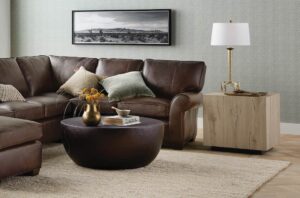Choosing between West Elm vs Poly and Bark for your home furnishings can be a challenge, especially when both brands offer a variety of options that seem equally appealing.
Knowing the importance of investing in the right furniture brand is crucial, as it not only impacts your daily life but also the aesthetic appeal of your home.
This article aims to provide a detailed comparison between the two brands to help you make an informed decision. By the end, you’ll have a clear understanding of what each brand offers, from quality and design to customer feedback and pricing options.
Origin and Brand Philosophy
Understanding the background and mission of each brand provides crucial context for making an informed choice. Let us delve into how West Elm vs Poly and Bark came to be, as well as the philosophies that guide them.
Background of West Elm
West Elm emerged in 2002 under the umbrella of its parent companies, Williams-Sonoma and Pottery Barn. The brand quickly established itself as a high-end furniture and home decor company catering to a younger audience who appreciate modern designs. A focus on sustainability also became evident, with 60% of the products supporting at least one sustainability initiative, and 35% of their wood furniture being FSC certified.
Note: West Elm’s furniture is primarily sourced overseas but assembled in the United States, ensuring quality control measures are in place.
Mission Statement of West Elm
West Elm’s mission is intertwined with sustainability and environmental responsibility. They strive to offer products that are not only aesthetically pleasing but also have a minimal impact on the environment. Their commitment to sustainability extends to using eco-friendly materials like FSC-certified wood, organic cotton, and recycled materials.
Background of Poly and Bark
Founded in Los Angeles, California, Poly and Bark is a newer entrant in the furniture industry compared to West Elm. It has branded itself as a provider of “The Internet’s favorite sofas,” aiming to deliver quality furniture at affordable prices. One unique feature is that Poly and Bark eliminates middlemen in its business model, enabling cost savings to be passed on to the consumer.
Mission Statement of Poly and Bark
The company’s mission centers around affordability without compromising on quality. Poly and Bark ensures that its materials are of top-notch quality, ranging from solid wood and metal to high-quality upholstery fabrics. They aim to make well-designed furniture accessible to the masses, underlining the brand’s commitment to value and design integrity.
This section sheds light on how both brands came into existence and their driving philosophies, thus setting the stage for a detailed evaluation of their respective offerings.
Range of Offerings
When evaluating West Elm vs Poly and Bark, the scope of their respective product lines is of utmost importance. Both brands offer a variety of furniture and home accessories, yet they differ in some key aspects, such as exclusive services and customization options.
Types of Furniture Offered by West Elm
West Elm boasts a wide array of offerings, from sofas and dining tables to lighting and rugs. Their product categories include:
- Living Room Furniture
- Bedroom Furniture
- Dining Room Furniture
- Outdoor Furniture
- Home Office Furniture
One notable attribute of West Elm’s product line is the inclusion of many designer collaborations that bring unique and limited edition pieces to the consumer.
Note: A substantial portion of West Elm’s inventory focuses on higher-end products, often made with sustainable materials.
Types of Furniture Offered by Poly and Bark
Poly and Bark, on the other hand, focus mainly on seating options, beds, and dining sets. The primary product categories include:
- Sofas
- Dining Chairs
- Beds
- Coffee Tables
Though the range is somewhat limited compared to West Elm, Poly and Bark excel in offering quality pieces at a more budget-friendly price point.
Exclusive Services from Each Brand
West Elm provides design consultation services and also offers a rewards program, which encourages repeat purchases. Poly and Bark have a straightforward online buying process, emphasizing easy returns and quick shipping.
Customization Options
West Elm offers extensive customization options for many of its furniture pieces, including a wide range of fabrics, colors, and finishes. Poly and Bark offer fewer customization opportunities but make up for it with ready-to-ship inventory that appeals to those who don’t wish to wait for customized orders.
The distinctions in the types of furniture offered, exclusive services, and customization options between West Elm and Poly and Bark provide useful insights for potential buyers.
Read Also: Bassett vs La-Z-Boy – Which Should You Choose?
Quality and Material Insights
Understanding the quality and materials used by West Elm vs Poly and Bark is essential for any informed purchasing decision. Both brands have their distinct approaches to quality control and material sourcing, setting them apart in the furniture industry.
West Elm Material Overview
West Elm primarily focuses on using sustainable and high-quality materials. Their commitment to sustainability can be seen through the use of:
- FSC-Certified Wood
- Organic Cotton
- Recycled Fabrics
- Fair Trade Certified™ products
This brand places a significant emphasis on ethical sourcing and sustainability, targeting a consumer base that values these principles.
Note: Many of West Elm’s products have labels indicating their eco-friendly material sourcing and ethical labor practices.
West Elm Quality Control
Quality control at West Elm involves rigorous testing for durability and safety. The brand often collaborates with external labs to ensure that its products meet or exceed industry standards.
Poly and Bark Material Overview
Poly and Bark opt for more budget-friendly materials without compromising quality. Their product lines often feature:
- Engineered Wood
- Metal Framework
- Polyurethane Cushions
- Vegan Leather
These choices enable Poly and Bark to offer cost-effective yet durable furniture options.
Poly and Bark Quality Control
Poly and Bark deploy a multi-stage quality control process, starting from material selection to the final production stage. Random sampling and stress tests are common procedures to ensure each product’s longevity and resilience.
By scrutinizing the materials and quality control practices of both brands, consumers can make an informed choice based on their needs and values.
Customer Perceptions
Analyzing customer perceptions about West Elm vs Poly and Bark offers valuable insights into the experiences one might expect from each brand. These impressions, both positive and negative, are instrumental for buyers considering one of these furniture providers.
General Customer Feedback for West Elm
Customer sentiment for West Elm frequently highlights the company’s focus on sustainable and high-quality materials. Many appreciate the elegant designs and the ethical manufacturing processes. Here’s a quick overview:
- Design Aesthetic
- Sustainability Practices
- Customer Service
Note: A common praise for West Elm involves their staff’s expertise and willingness to assist in making informed choices.
Issues Customers Have Faced with West Elm
While many customers are content with their purchases, there are reports of:
- Delivery Delays
- Difficulty with Returns
- Product Availability
These issues suggest that, while West Elm scores high on product quality, logistical aspects occasionally fall short.
General Customer Feedback for Poly and Bark
Poly and Bark generally receive favorable reviews for their affordability and modern designs. Customers mention:
- Budget-Friendly Options
- Trendy Designs
- Quick Shipping
Issues Customers Have Faced with Poly and Bark
On the downside, some customers report:
- Inconsistency in Product Quality
- Limited Customization
- Assembly Difficulties
These challenges indicate that while Poly and Bark excel in offering affordable furniture, there might be compromises on customization and uniform quality.
Understanding the range of customer feedback can be enlightening, allowing prospective buyers to weigh the pros and cons before committing to either brand.
How Does Shipping Work
For many customers, shipping policies and delivery timeframes are crucial factors in choosing between West Elm and Poly and Bark. Both companies have their own distinct approaches to delivering their furniture to your doorstep.
West Elm Shipping Policies
West Elm typically offers a range of shipping options, catering to diverse customer needs. These can vary from standard to expedited services. Several shipping methods are usually available:
- White Glove Service
- Standard Ground Shipping
- Expedited Options
Note: West Elm may apply additional fees for large, bulky items, so it’s advisable to read the fine print before placing an order.
West Elm Delivery Timeframes
Customers can generally expect:
- Standard Shipping: 5-7 business days
- Expedited Shipping: 2-3 business days
The exact timeframe can vary based on product availability and the delivery location.
Poly and Bark Shipping Policies
Poly and Bark also offer several shipping options, most notably:
- Free Standard Shipping
- Paid Expedited Services
Unlike West Elm, Poly and Bark often provide free standard shipping regardless of the purchase size, which many customers find appealing.
Poly and Bark Delivery Timeframes
For Poly and Bark, customers commonly encounter:
- Standard Shipping: 7-10 business days
- Expedited Shipping: 3-5 business days
It’s worth noting that Poly and Bark usually ship items faster if they are readily available in their warehouse.
Comparing the shipping policies and timeframes of both companies gives one a clear understanding of what to anticipate regarding delivery when making a purchase.
Examining the Assembly Process
The assembly process can be a determining factor when opting for West Elm or Poly and Bark. Both companies offer varied assembly services that suit different customer needs, so understanding these can guide your purchasing decision.
What West Elm Offers for Assembly
West Elm gives customers several options when it comes to assembly. The standard practice usually involves:
- Pre-assembled items
- Partially assembled items requiring minor adjustments
- DIY assembly kits with instructions
Note: The level of assembly required is typically mentioned in the product description.
Additional Services like White Glove
For those who prefer to sidestep the assembly process, West Elm offers a White Glove Service, which includes:
- Delivery to your room of choice
- Full assembly of the product
- Removal of all packaging materials
What Poly and Bark Offers for Assembly
Poly and Bark also aim to make the assembly process as convenient as possible. They often offer:
- Easy-to-assemble kits with straightforward instructions
- Pre-assembled items
- Partially assembled items with minimal required effort
Additional Services from Poly and Bark
While Poly and Bark do not have an equivalent to West Elm’s White Glove Service, they do offer:
- Scheduled delivery
- Partial assembly for complex items at an additional fee
- Professional setup services, available upon request
Understanding the assembly services provided by both West Elm and Poly and Bark can assist customers in choosing the most suitable option. The additional services, like West Elm’s White Glove or Poly and Bark’s professional setup, can further streamline the process for those willing to invest a little extra.
Pros and Cons of Each Brand
The ultimate choice between West Elm and Poly and Bark often boils down to the pros and cons of each brand. Each has its own set of advantages and limitations that cater to specific consumer needs. This section aims to provide a balanced view to help you make an informed decision.
Benefits of Choosing West Elm
Advantages:
- Wide variety of design styles
- High-quality materials
- Established brand reputation
- White Glove Service available
- Frequent sales and discounts
Drawbacks of Choosing West Elm
Limitations:
- Higher pricing on average
- Some assembly may be required
- Less flexible return policy
Note: The price point may be a concern for budget-conscious shoppers.
Benefits of Choosing Poly and Bark
Advantages:
- Budget-friendly options
- Simplified assembly process
- Diverse product offerings
- Flexible return policy
- Strong focus on customer service
Drawbacks of Choosing Poly and Bark
Limitations:
- Less variety in design styles
- Limited premium offerings
- May require professional setup for some items
The choice between West Elm vs Poly and Bark will depend on what you prioritize—be it design, quality, or budget. West Elm offers an extensive design variety and has an established brand reputation but comes at a higher price point. On the other hand, Poly and Bark offers cost-effective, quality alternatives but may have limitations in design styles and premium options.
Pricing and Financial Plans
Evaluating the financial aspects of your potential purchase is crucial. This section dissects the pricing and various payment options available at both West Elm vs Poly and Bark. It further offers an affordability comparison to assist you in making an astute financial decision.
West Elm Credit Card and Rewards
West Elm offers a branded credit card that comes with its own set of perks:
- Reward points on purchases
- Exclusive cardholder events
- Zero annual fees
- Special financing options
Note: Consider your spending habits and whether you can make full use of the rewards before applying for the card.
Payment Options at West Elm
West Elm provides a wide array of payment methods for your convenience:
- Credit/Debit cards
- PayPal
- Wire Transfer
- Gift Cards
Payment Options at Poly and Bark
Poly and Bark too offers multiple avenues for payment, albeit with a more streamlined list:
- Credit/Debit cards
- PayPal
- Affirm Financing
Affordability Comparison
To give you a clearer financial picture, let’s compare the affordability of products at both stores.
| Criteria | West Elm | Poly and Bark |
|---|---|---|
| Average Price Range | $200 – $4000 | $100 – $2000 |
| Financing Options | Available | Available |
| Frequent Sales and Offers | Yes | Limited |
While West Elm generally has a higher price range, it often offers sales and financing options that can offset costs. Poly and Bark, on the other hand, is initially more budget-friendly but offers fewer sales and discounts.
Your financial strategy in choosing between the two brands will hinge on your own priorities—whether you’re looking for premium products and are willing to invest more, or are seeking budget-friendly yet quality alternatives.
Read Also: West Elm vs CB2 – Which Offers Greater Value?
Conclusion
Arriving at a decision between West Elm vs Poly and Bark requires a meticulous evaluation of various aspects—quality, range, customer service, and more. Both brands offer distinct advantages and drawbacks, each appealing to a specific set of consumer preferences.
West Elm appeals to those who prioritize premium quality and a wide array of choices, while Poly and Bark focuses on delivering streamlined, budget-friendly options.
Do you prioritize quality or affordability? Your personal preferences in this matter will guide your ultimate choice between these two brands.
West Elm offers more choices and has a rewards system, albeit at a higher price point. Poly and Bark is more affordable but offers fewer perks and sales.
If your focus is on long-term investment and a wider array of options, West Elm could be your go-to. For those seeking cost-effective yet quality furnishings, Poly and Bark is worth considering.





